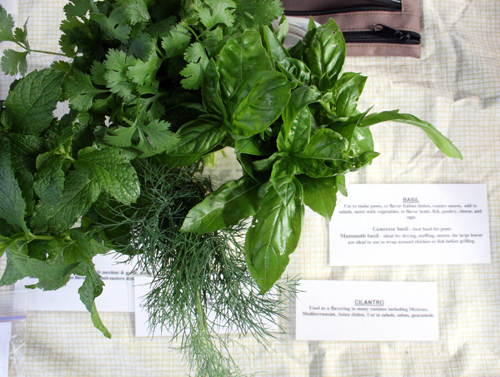University of Georgia horticulturist Bodie Pennisi doesn’t just study herbs in her research garden in Griffin, Ga. She also grows them at home to add flavor to her food.
“I grow herbs because I use them in my kitchen,” she said, “and I do quite a bit of cooking. I use them fresh, and I use them dry, so I have to know which will grow in containers [and] in the ground, how to preserve them and use them the best.”
Her general message is to “eat more herbs,” she said. “Using herbs in the kitchen is a dietary way to help yourself in not eating too much salt and increasing the flavor in your food.”
All herbs like well-drained soils, so she’s found it easiest – and better for the plants – to grow them in pots. The exceptions are rosemary and thyme, which can be planted as ground cover in sunny areas. Sage can also be grown in the ground, but Pennisi has found, “in my view, it likes the pot a little bit better.”
Because herbs grow well in pots, they are easy to transport indoors and back outdoors depending on the weather.
“You can grow just about anything if you put it in the house,” she said, “but you have to give it a lot of sun. A southern-exposure window is the best. But, you’re never going to get the good growth you get outside.”
Both dried and fresh herbs can be found at most grocery stores. Dried herbs usually come in bottles. Fresh herbs can be found in the produce section, usually bunched, in a bag or enclosed in a tube. But Pennisi prefers hers grown at home. And in the winter when fresh isn’t readily available, she’s prepared.
“It’s a lot better if you grow them yourself,” she said. “And dry them yourself, but don’t hold them dried for more than a year. I dry my own lemon balm and mint for tea. It’s not hard.”
To dry herbs, she uses an inexpensive plastic dehydrator. In the summer when the air inside her house is dry due to the air conditioning, she hangs them in her kitchen.
Below are a few of Pennisi’s favorite herbs and a few tips for growing them.
• Basil. “You can start from seed or purchase it in plant form,” she said. Basil can vary from the most common – a wide-leafed variety – to the small-leafed lemon basil and purple opal basil, which has dark maroon-purple leaves. It should be grown in full sun and well-drained soil. As soon as its flower heads appear, these should be pinched back to prevent the plant from going to seed.
• Thyme. There are more than 400 varieties of thyme, with English thyme being the most common. For the South, Pennisi suggests growing lemon thyme, caraway thyme and mother-of-thyme. Thyme varieties that creep make an excellent ground cover.
• Sage. A perennial plant, sage varieties can be used interchangeably in cooking. Once it is established, it usually does well in well-drained soils. One particular variety of sage, known as pineapple sage, can be used to flavor drinks, chicken dishes, cheeses, jams and jellies.
• Rosemary. Rosemary can be enjoyed year-round from the garden, because it too is a perennial plant. The shrubby plant can grow to between 3 and 5 feet tall. It’s drought-resistant after it’s established, but should be planted in full sun. “If you see that the plant is not growing vigorously, it’s a sign that it’s not getting enough sun,” Pennisi said.
• Mint. Mint should always be grown in a pot, she said, because once it’s planted in the ground, it can take over. “The same goes for oregano and marjoram,” she said. “They’re a little too happy to grow.” The invasive mint can tolerate partial shade. Pennisi likes to grow peppermint and spearmint varieties to add to her tea.
• Winter and summer savory. Winter savory has smaller, darker green leaves, a stronger flavor and is a perennial. It grows best from cuttings. Summer savory grows more easily from seed. Both require full sun.
• Chives. Chives are a member of the onion family. “It’s basically your onion,” she said. “Onion chives are planted each year. The garlic chives have flat leaves, and they’re perennial.” They are easy to grow, but require a balanced fertilizer to grow well. Onion chives have pink flowers, while garlic chives have white flowers.
• Lemon balm. “I like lemon balm for tea,” she said. Lemon balm is a perennial that can spread up to 3 feet. It will grow in partial shade.










